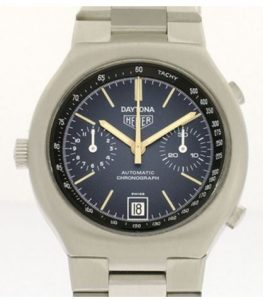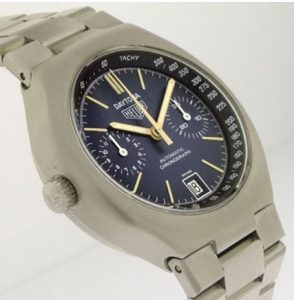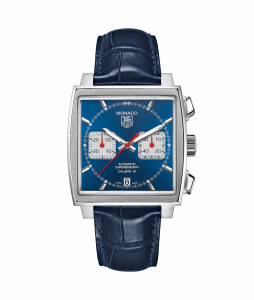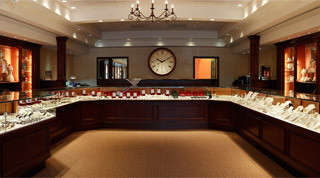TAG Heuer makes a Daytona?
The TAG Heuer Daytona is far less well known than the Rolex Daytona, so people are often surprised to find out that Rolex doesn’t have an exclusive on naming a watch after the famous racetrack. We think TAG Heuer’s Chronograph Daytona stands on its own.


Introduced in the 70s and produced for only four years, from 1976 to 1980, the TAG Heuer Daytona ref R110203B is a rare find. The blue TAG Heuer Daytona, shown here, 110203B, is the more desirable model. Note how the dial has a subtle gradient from a lighter center to a darker outer edge, giving the face a dramatic spotlight effect. The 110203F is a smoky color called “fume”, without the lighting effect.
The Daytona’s flange tachymeter
One of the most interesting features of the TAG Heuer Daytona is the Tachymeter flange. You can see, below, how it frames the sunken dial. It gives the watch a great dashboard feel. Since TAG made its mark in dashboard clocks for everything from cars and boats to airplanes, it’s a nod to a prominent heritage.


What does a tachymeter do?
A tachymeter converts either rate of speed or distance from the seconds passed. If you know the distance traveled and the time spent traveling, you can calculate the speed (assuming it’s constant.) For example, start the timer at zero (twelve o’clock) and time a racecar going one mile in 20 seconds, ending at the 4 o’clock position. See the 180 on the flange, next to the 4 o’clock marker? The tachymeter indicates a travelling speed of 180 miles per hour. Here’s a video that explains it simply.
The Daytona’s movement
Up to 1976, TAG Heuer used two movements in their watches: the Calibre 11 and 12. The in-house automatic Calibre 11 Chronomatic movement is the one used in the Daytona. In 1977, after the Daytona, TAG switched to a Valjoux 7750 movement, used in the Kentucky and Pasadena models.
Styled in Stainless
The TAG Heuer Daytona has a beautiful brushed stainless steel 39mm case and only came with a stainless steel bracelet, smoothly integrated with the lugs for a sleek, aerodynamic look.
Bypassed by the quartz trend, now a rare collectible
The Daytona was launched just as low-priced quartz watches came on to the playing field, when the entire field of mechanical watches took a back step to their popularity. Today, these Daytonas are hard to find in good condition. The chief complaint is that the luminous hands and markers fade from the original white to a cream or, in some cases, down to orange.
TAG Heuer’s history with racing
The company has had a long history with cars and the sport of racing. They patented the first chronograph for the dashboard in 1911 and the first wrist chronograph in 1914. In 1953 and 1954, they produced an “Auto-Graph” for Abercrombie & Fitch, used by rally car drivers to clock their pace.
TAG had long been relied on for dashboards from everything from cars to planes, and their stopwatches were standard sports equipment. That made the brand a perfect fit for the racing world, including the Indy 500, and TAG Heuer introduced several models with car or racing names, the most famous of which is the iconic Monaco worn by Steve McQueen in the movie Le Mans. Today, they partner with Red Bull to sponsor races, even winning the 2016 Spanish Grand Prix.





